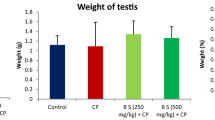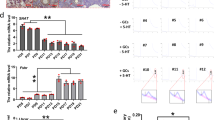Abstract
Ricinus communis L. has ethnopharmacological contraceptive reputation but its stem bark has unexplored mechanisms of action in female reproductive system. In the present study, the effect of methanolic and aqueous extracts from the stem bark of the plant was examined on basic porcine ovarian granulosa cell functions and its response to Luteinising hormone (LH)—the upstream hormonal regulator. Systemic treatment of methanolic and aqueous extracts stimulated cell proliferation (proliferating cell nuclear antigen, PCNA) and also promoted cell apoptosis (caspase-3). Aqueous extract has inverted the stimulatory effect of LH on PCNA but not on caspase-3. Methanolic extract stimulated as well as inhibited progesterone release and stimulated testosterone secretion. Whereas aqueous extract inhibited both steroid releases and suppressed the stimulatory effect of LH on progesterone release and promoted the inhibitory effect of LH on testosterone release. In conclusion, the present study unveils the mechanism of action of R. communis stem bark in in vitro condition. These suggest its possible contraceptive efficacy by exerting its regulatory role over LH and on basic ovarian cell functions and secretion activity.
This is a preview of subscription content, access via your institution
Access options
Subscribe to this journal
Receive 8 print issues and online access
$259.00 per year
only $32.38 per issue
Buy this article
- Purchase on Springer Link
- Instant access to full article PDF
Prices may be subject to local taxes which are calculated during checkout







Similar content being viewed by others
References
Choudhury N, Mahanta B, Kalita JC . An ethnobotanical survey on medicinal plants used in reproductive health related disorders in Rangia subdivision, Kamrup district, Assam. IJSAT 2011; 1: 154–159.
Nath S, Dutta Choudhury M, Roychoudhury S, Das Talukdar A, Sirotkin AV, Bakova Z et al. Restorative aspect of castor plant on mammalian physiology: a review. JMBFS 2011; 1: 236–246.
Kalita JC, Chakrabarty A, Tanti B . Assessment of antifertility activity of some traditionally used plants by different ethnic communities in three districts of Assam, India. J Herb Med Toxicol 2011; 5: 65–72.
Saharia S, Sarma CM . Ethno-medicinal studies on indigenous wetland plants in the tea garden tribes of Darrang and Udalguri district, Assam, India. NeBIO 2011; 2: 27–33.
Das B, Dutta Choudhury M, Das Talukdar A . A few traditional medicinal plants used as antifertility agents by ethnic people of Tripura, India. IJPPS 2014; 6: 47–53.
Okwuasaba FK, Osunkwo UA, Ekwenchi MM, Ekpenyong KI, Onwukeme KE, Olayinka AO et al. Anticonceptive and estrogenic effects of seed extract of Ricinus communis var. minor. J Ethnopharmacol 1991; 34: 141–145.
Makonnen E, Zerihun L, Assefa G, Rostom AA . Antifertility activity of Ricinus communis seed in female guinea pigs. East Afr Med J 1999; 76: 335–337.
Salhab AS, Shomaf MS, Gharaibeh MN, Amer NA . Effects of castor bean extract and ricin A-chain on ovulation and implantation in rabbits. Contraception 1999; 59: 395–400.
Zhang X, Han F, Gao P, Yu D, Liu S . Bioassay-guided franctionation of antifertility components of castorbean (Ricinus communis L.) seed extracts. Nat Prod Res 2007; 21: 982–989.
Salhab AS, Issa AA, Alhougog I . On the contraceptive effect of castor beans. Pharm Biol 1997; 35: 63–65.
Salhab AS, Al-Tamimi SO, Gharaibehand Maha MN, Shomaf S . The abortifacient effects of castor bean extract and ricin-A chain in rabbits. Contraception 1998; 58: 193–197.
Meena AK, Rao MM . Folk herbal medicines used by the Meena community in Rajasthan. Asian J Trad Med 2010; 5: 19–31.
Goncim HY, Mador ES, Ogunranti JO . Ricinus communis var Minor Inhibits follicular development and possibly ovulation in human subjects as shown by ultrasound follicle tracking. CMRH 2010; 4: 35–38.
Venkataraghavan S, Sundaresan TP . A short note on contraceptive in Ayurveda. J Sci Res Pl Med 1981; 2: 39.
Srivastava RC, Nyishi C . Traditional knowledge of Nyishi (Daffla) tribe of Arunachal Pradesh. IJTK 2010; 9: 26–37.
Nath S, Dutta Choudhury M, Roychoudhury S, Das Talukdar A, Misro MM . Male contraceptive efficacy of Ricinus communis L. extract. J Ethnopharmacol 2013; 149: 328–334.
Sirotkin AV . Growth factors controlling ovarian functions. J Cell Physiol 2011; 226: 2222–2225.
Kolesarova A, Bakova Z, Capcarova M, Galik B, Juracek M, Simko M et al. Consumption of bee pollen affects rat ovarian functions. J Anim Physiol Anim Nutr (Berl) 2013; 97: 1059–1065.
Conneely OM, Mulac-jericevic B, DeMayo F, Lydon JP, O’Malley BW . Reproductive functions of progesterone receptors. Recent Prog Horm Res 2002; 57: 339–355.
Qin Y, Zhao Z, Sun M, Geng L, Che L, Chen ZJ . Association of basal serum testosterone levels with ovarian response and in vitro fertilization outcome. Reprod Biol Endocrinol 2011; 9: 9.
Iyenger MA . Study of Crude Drugs, 8th edn. Manipal Power Press: Manipal, India, 1995; 2.
Siddiqui AA, Ali M . Practical Pharmaceutical Chemistry 1st edn. CBS Publishers and Distributors: New Delhi, 1997; 126–131.
Kokate CK . A Textbook for Practical Pharmacognosy, 5th edn. Vallabh Prakashan: CBS Publishers and Distributors, New Delhi, India, 2005, pp 107–111.
Sirotkin AV, Chrenek P, Darlak K, Valenzuela F, Kuklova Z . Some endocrine traits of transgenic rabbits. II. Changes in hormone secretion and response of isolated ovarian tissue to FSH and ghrelin. Physiol Res 2008; 57: 745–751.
Bird C, Kirstein S . Real-time, label-free monitoring of cellular invasion and migration with the xCELLigence system. Nat Methods 2009; 6: v–vi.
Ozturk F, Malkoc S, Ersoz M, Hakki SS, Bozkurt BS . Real-time cell analysis of cytotoxicity of orthodontic cements on gingival fibroblasts. J Orthod Res 2014; 2: 32–37.
Osborn M, Isenberg S Immunocytochemistry of frozen and paraffin tissue sections. In: Ceils JE, editor. Cell Biology, a Laboratory Handbook. Academic Press: New York, 1994; 2: 361–367.
Prakash BS, Meyer HH, Schallenberger E, van de Wiel DF . Development of a sensitive enzymeimmunoassay (EIA) for progesterone determination in unextracted bovine plasma using the second antibody technique. J Steroid Biochem 1987; 28: 623–627.
Munster E . Entwicklung von enzymimmunologischen Messverfahren auf Mikrotitrationsplatten zur Bestimmung von Testosteron und Progesteron im Blutplasma. PhD Thesis. Institute for Animal Production and Breeding of the University of Hohenheim: Germany, 1989; 154.
Maga G, Hubscher U . Proliferating cell nuclear antigen (PCNA): a dancer with many partners. J Cell Sci 2003; 1: 3051–3060.
Hashimoto T, Kikkawa U, Kamada S . Contribution of caspase(s) to the cell cycle regulation at mitotic phase. PLoS One 2011; 6: e18449.
Walters KA, Allam CM, Handelsman DJ . Androgen actions and the ovary. Biol Reprod 2008; 78: 380–389.
Sasaki YuF, Imanishi H, Ohta T, Watanabe M, Matsumoto K, Shirasu Y . Suppressing effect of tannic acid on the frequencies of mutagen-induced sister-chromatid exchanges in mammalian cells. Mutat Res 1989; 213: 195–203.
Kobayashi T, Nakata T, Kuzumaki T . Effect of flavonoids on cell cycle progression in prostate cancer cells. Cancer Lett 2002; 176: 17–23.
Haddad AQ, Venkateswaran V, Viswanathan L, Teahan SJ, Fleshner NE, Klotz LH . Novel antiproliferative flavonoids induce cell cycle arrest in human prostate cancer cell lines. Prostate Cancer Prostatic Dis 2006; 9: 68–76.
Hasegawa E, Nakagawa S, Sato M, Tachikawa E, Yamato S . Effect of polyphenols on production of steroid hormones from human adrenocortical NCI-H295R. Biol Pharm Bull 2013; 36: 228–237.
Uadkla O, Yodkeeree S, Buayairaksa M, Meepowpan P, Nuntasaen N, Limtrakul P et al. Antiproliferative effect of alkaloids via cell cycle arrest from Pseuduvaria rugosa. Pharm Biol 2013; 51: 400–404.
Diczfalusy E . Mode of action of contraceptive drugs. Am J Obstet Gynecol 1968; 100: 136–162.
Lin WH, Feng HP, Shadle CR, O’Reilly T, Wagner JA, Butterton JR . Pharmacokinetic and pharmacodynamic interactions between the hepatitis C virus protease inhibitor, boceprevir and the oral contraceptive ethinyl estradiol/norethindrone. Eur J Clin Pharmacol 2014; 70: 1107–1109.
Zhang X, Rowell L, Fettner S, Lau S, Teuber D . Assessment of disease-drug-drug interaction between single-dose tocilizumab and oral contraceptives in women with active rheumatoid arthritis. Int J Clin Pharmacol Ther 2014; 52: 27–38.
Schally AV, Arimura A, Bowers CY, Kastin AJ, Sawano S, Reeding TW . Hypothalamic neurohormones regulating anterior pituitary function. Recent Prog Horm Res 1968; 24: 497–588.
Acknowledgements
We are thankful to Slovak Academic Information Agency (SAIA, project no. SAIA 185-2011) and National Scholarship Programme of Government of Slovakia summer session 2011, Slovak Agency for Promotion of Research and Development (APVV, projects no. 0137-10 and 0854-11) and Operational Programme Research and Development funded from the European Regional Development Fund (project no. 26220220176) for their financial support to carry out the experiments. We are thankful to Mrs. Katarina Tothova and Ing. Zofia Kuklova (Animal Production Research Centre, Nitra-Luzianky) for their technical help to carry out the experiments and to Mrs. Iris Stelter (Institute of Animal Science, Neustadt, Germany) for performing the hormone EIA. We would also like to extend our deep sense of gratitude to University Grants Commission, Government of India. DBT- DeLCON, Bioinformatics Centre, Assam University and Assam University Biotech Hub are sincerely acknowledged.
Author information
Authors and Affiliations
Corresponding author
Ethics declarations
Competing interests
The authors declare no conflict of interest.
Rights and permissions
About this article
Cite this article
Nath, S., Kadasi, A., Grossmann, R. et al. Ricinus communis L. stem bark extracts regulate ovarian cell functions and secretory activity and their response to Luteinising hormone. Int J Impot Res 27, 215–220 (2015). https://doi.org/10.1038/ijir.2015.19
Received:
Revised:
Accepted:
Published:
Issue Date:
DOI: https://doi.org/10.1038/ijir.2015.19
This article is cited by
-
North American Fertility–Regulating Botanicals: a Review
Economic Botany (2022)



